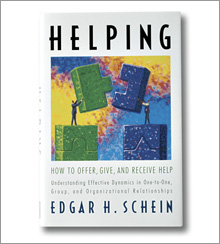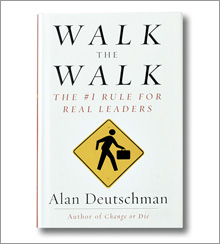Best Business Books 2009: Leadership
Means to a Greater End
(originally published by Booz & Company)Kenneth Hopper and William Hopper
The Puritan Gift: Reclaiming the American Dream amidst Global Financial Chaos
(revised ed., I.B. Tauris, 2009)
Warren Bennis, Daniel Goleman, and James O’Toole, with Patricia Ward Biederman
Transparency: How Leaders Create a Culture of Candor
(Jossey-Bass, 2008)
Edgar H. Schein
Helping: How to Offer, Give, and Receive Help
(Berrett-Koehler, 2009)
Alan Deutschman
Walk the Walk: The #1 Rule for Real Leaders
(Portfolio, 2009)
C. Julia Huang
Charisma and Compassion: Cheng Yen and the Buddhist Tzu Chi Movement
(Harvard University Press, 2009)
If ever there was a time when leadership was badly needed and sorely tested, it was during the 12 months after October 2008. The financial crash that almost became a catastrophe was a self-inflicted wound. It did not need to happen. There were warnings enough from concerned observers of troubles ahead, but those in positions of power in leading organizations paid no heed until it was too late.
As financial journalist Gillian Tett put it in her book Fool’s Gold: How the Bold Dream of a Small Tribe at J.P. Morgan Was Corrupted by Wall Street Greed and Unleashed a Catastrophe (Free Press, 2009; see “A Wealth of Explanations,” by Clive Crook), the “social silence” around the explosion of derivatives, and around the wealth and influence of the banking cadre, encouraged financiers to regard their activities as detached from the rest of society, until they became “like the inhabitants of Plato’s cave, who could see shadows of outside reality flickering on the walls but rarely encountered that reality themselves.” Nor did they show interest in looking outside. Too many leaders, ensconced in their tall towers, insulated themselves from the world they were supposed to be serving and forgot what they were about.
Lesson from Our Forefathers
The best reminder of that underlying purpose comes from a book by brothers Kenneth and William Hopper — Kenneth, an engineer in business in the U.S.; William, an investment banker in London. The Puritan Gift: Reclaiming the American Dream amidst Global Financial Chaos may have escaped notice when first published in 2007 because of its unusual title, but this year’s paperback with a new preface by that wise man Russell Ackoff deserves rediscovery at this critical time. “Puritan gift” refers to what the authors describe as the United States’ superb managerial culture as established by the descendants of the country’s early settlers. Those settlers sought to create God’s kingdom on earth in New England in the 17th century. As businessmen they also needed to earn a return on capital but saw no conflict between the two. Profit to them was the means to a greater end.
The Puritan gift, therefore, is that rare ability to create and manage organizations that serve a useful purpose in society. As the authors note, it later inspired the creation of a federal political culture that enabled 13 obscure colonies at the edge of the civilized world to transform themselves, with the passage of time, into a great power. This managerial culture was even successfully transplanted to Japan under the U.S. occupation after World War II and turned a poor country lacking natural resources into the second-richest in the world.
It was, the Hoppers suggest, the United States’ gift to the world until sometime around 1970, when profit-and-loss accounting began to take priority, a time they describe as “the years that the locust ate.” It was then that the cult of the expert and the rise of the so-called professional manager shifted the focus of management to money as the measure that mattered, for self and organization. The elevation of shareholder value as the main criterion of business success mistook the means for the ends, a classic category error for logicians, but a calamitous strategic mistake for leaders. This error was compounded when managerial reward was tied to share value.
The Puritan Gift, this year’s best leadership book, is partly a history of American business, but it is also a lament for the decline of the collegial style of leadership that drove what the authors call the “great engines of growth and prosperity” and that was replaced by the “imperial” rule of the professional CEO in so many companies. It is a reminder of what made the U.S. great and a heartfelt plea for its recall.
The other four books I have selected for this review do not pretend to be as all-encompassing as The Puritan Gift, but they provide insights into important aspects of the leader’s role. The first deals with the need for truth (or candor, as the authors call it) in organizations, something that has been badly missing of late. The second is a primer on helping, a key facet of a good leader’s work. The final two provide vivid and valuable examples of leadership in practice, largely but not wholly drawn from business organizations.
Leadership and Truth
Warren Bennis, Daniel Goleman, and James O’Toole are three of the most influential management thinkers around. Accordingly, Transparency: How Leaders Create a Culture of Candor, their combined take on the key challenges facing business today, has to be taken seriously. The book takes the form of three individual essays, one by each of the main authors.
Bennis looks at the consequences of what Thomas Friedman has described as the flattening of organizations, made possible by new technologies. As information, and with it power, is shared more widely, communication across the organization as well as vertically becomes ever more crucial. Openness and honesty are essential. But being honest in an organization is more difficult than it sounds. People hoard information, indulge in groupthink, tell their bosses only what they think they want to hear, and ignore facts that are staring them in the face. As Bennis points out, “Technologies change. Human nature doesn’t.” The book, he says, is about “the things that have mattered since the new technology was the flint and the longbow — courage, integrity, candor, responsibility.”
In his eloquent and moving essay, O’Toole argues that “speaking truth to power is, perhaps, the oldest of all ethical challenges.” To make his point, he refers the reader to classics of literature — to Sophocles’ Antigone, John Osborne’s Luther, and Robert Bolt’s A Man for All Seasons, the story of Sir Thomas More. O’Toole is at his best in bringing these texts to illuminate our current condition, but he also cites contemporary organizations such as FedEx and Motorola. The prime responsibility of leaders, he argues, is to create “a culture of candor” in which they are constantly “willing to rethink even their most basic assumptions through a process of constructive dissent.” The culture must be one in which every individual is encouraged to speak the truth, because only then can proper trust be established — trust that is the basis of all effective leadership but also the most elusive and fragile of things, so hard to establish, so easy to lose.
Transparency is a slight book, carefully crafted and easy to read. The messages may be as old as time, but they are no less important for that. Of course, those messages are easier to deliver than to act on, and the authors refrain from offering specific recommendations for action. They don’t need to. To tell the truth is all that one has to adhere to, even when it hurts, and that example has to come from the top.
Leadership as Helping
Ed Schein knows a lot about organizations. He has been working with them, advising them, studying them, and, yes, helping them and many of their leaders for decades. Helping: How to Offer, Give, and Receive Help is a small book that is his reflective summary of what works in a helping relationship and how to make it happen. He is uniquely qualified to do this, combining, as he does, a knowledge of sociology, anthropology, and social psychology, as well as long years of teaching executives at the Sloan School of Management at MIT. (Schein was my thesis supervisor 40 years ago, at MIT, and has been a good friend ever since, so I have firsthand experience of his help.)
Helping, Schein points out, takes many forms. He lists 30 helping situations, including a boss giving instructions to a subordinate, a stranger giving traffic directions to a tourist, and a child showing a parent how to play a computer game. Further, he draws heavily on his experience helping his wife cope with breast cancer over 25 years, involving periodic visits to hospitals and home care, with all the different relationships involved.
And help, as Schein points out, is not limited to one-on-one situations. Group effort and teamwork often hinge on the degree to which members perform their roles properly in accomplishing the group’s task: “We do not typically think of an effective team as being a group of people who really know how to help each other...yet that is precisely what good teamwork is — successful reciprocal help,” he writes. Schein also lists 27 synonyms for helping. One way or another, it seems, we are helping or being helped most days of the week. The book is therefore a practical guide to everyday life, as well as an invaluable guide for all those who have some responsibility for others, be they students, subordinates, or clients of one sort or another.
Schein’s main thesis is that all human relationships are a mixture of economics and theater, because they all involve what sociologists call “status positioning” between the parties involved in any social interaction, whether formal or informal. It is human to want to be granted the status and position that we feel we deserve, no matter how low or high that is, and to want to do what is appropriate to the situation and the occasion. If we get it wrong, the relationship doesn’t work. A very simple example: If a child fails to say thank you, a social expectation has not been met and the child is reprimanded. We also intuitively and almost unconsciously measure interactions by how much we have gained or lost, compared to our expectations. Thus, for a helping interaction to work, each party needs to be clear about the role each is playing, and all parties’ expectations of the outcome have to be similar.
After explaining the many pitfalls of helping — why well-intentioned advice is perceived as criticism, how the different social rules in individual cultures create unintended offense, how a tone of voice or form of address can alter a relationship in an instant — Schein offers seven principles and 18 tips, because this is, above all, a book of practical help.
These often sound obvious but, as the examples demonstrate, we often ignore his principles amid the daily course of life, taking for granted relationships and exchanges that may not be what they seem. We get lazy. I found this little book a salutary reminder of too many lapses on my part, while it also explained why some of my well-intentioned attempts to help only led to worsening relationships. Any aspiring leader would do well to review his or her own behavior in the light of this very useful guide.
Leadership by Example
Alan Deutschman is a journalist, which is fortunate for us, the readers, because not only does he write fluently and vividly, but he tells stories, which is what all good journalists do. Walk the Walk: The #1 Rule for Real Leaders is a compendium of stories taken from the interviews he has conducted with leaders over the past 20 years, most of them in business but some, equally relevant and revealing, from the worlds of sports and politics. Deutschman’s subjects range from Jeff Bezos of Amazon.com to Barack Obama in the first week of his presidency, from FedEx to the Florida Gators, Nelson Mandela, and the Greensboro Four, whose lunchtime sit-ins in 1960 helped to jump-start the desegregation movement in the United States.
The stories make for compelling reading, particularly because they are not all paeans to the individuals profiled. Deutschman is critical of quite a few leaders, including California Governor Arnold Schwarzenegger for talking the talk about energy and the environment but continuing to own a fleet of five Hummers. The fact that, in response to criticism, Schwarzenegger got General Motors to retrofit one of the vehicles to run on hydrogen and another on biofuel was not helpful, suggests Deutschman, because neither fuel is readily available to his constituents. Obama, too, comes in for some mild criticism for not leading enough by example in the very early days, although he is praised for many of his initiatives.
Deutschman uses his stories to make a point, or several points. He starts with the statement that “the most crucial role of a leader is establishing and instilling the one or two values that will be most important for an organization or a movement or a community.” There are always a multitude of values that are important — the hard part is making the trade-offs between them in order to focus on one or two. He castigates Coca-Cola for its list of six goals and seven values, many of which are potentially contradictory: Were “people” more important than “profit,” and where did “integrity” come in the pecking order?
It is, Deutschman says, only when you walk the walk that you reveal the ranking of your values. He describes the response of Martin Luther King Jr. when he was attacked by Roy James, a Nazi sympathizer, in Birmingham, Ala., in 1962. King staggered back under a rain of blows, but dropped his hands and refused to fight back. He turned the other cheek. He walked his walk, lived his teaching, and so demonstrated that others, too, could live by his principles. Deutschman contrasts King’s behavior with stories of corporations and chief executives that have ignored their declared values and principles when it suited them to do so or when they went along with the prevailing customs of their industry, most flagrantly in the case of the airline companies. Deutschman labels them lemmings, those who follow the herd rather than setting their own standards.
Deutschman distills his long list of stories into a series of principles. Although these are obvious, like so much in the literature of leadership, it is the stories that bring them to life. My recommendation would be to read the stories and make a note of the ones that resonated most with your own situation, underline the simple message that they contain, and then resolve to act on it or, as Deutschman would say, to walk your walk.
Inspired by Compassion
There is only one story in C. Julia Huang’s Charisma and Compassion: Cheng Yen and the Buddhist Tzu Chi Movement, but it is a remarkable one and a vivid example of Deutschman’s advice to live your values. Venerable Master Cheng Yen, now 72 years old, is an unassuming Taiwanese Buddhist nun who founded a worldwide social welfare movement with more than 10 million devotees in more than 30 countries, 5 million of them in Taiwan itself and the majority of the remainder in the United States. This remarkable organization, the Tzu Chi Foundation, which started as a tiny grassroots women’s charitable group in 1966, now runs three state-of-the-art hospitals in Taiwan, a university, and a television station, as well as an international relief organization that provides money and provisions to those affected by disasters, including the tsunami in Sri Lanka, Hurricane Noel in the Dominican Republic, and floods in Indonesia and the Midwestern United States. Cheng Yen has been nominated for the Nobel Peace Prize and is well known as a Buddhist peace activist. She was also identified by Business Week as an entrepreneurial star.
Cheng Yen’s leadership story started in 1966 when she was visiting a sick friend at a hospital and noticed a pool of blood on the floor. She was told that an Aboriginal woman had miscarried because, after being carried for eight hours by her family to the hospital, she was refused treatment without the NT$8,000 deposit (then about US$400). When Cheng Yen learned that the woman had died, she resolved to start a mission to defray medical costs for the poor. She began by mobilizing the resources of her disciples in her local Buddhist community, asking them to make baby shoes to sell and also to place NT$0.50 (about US$0.025) each morning in a bamboo container before doing the daily grocery shopping. In one month the daily practice of “50 cents to save one human life” had started to spread, and an organization of sorts was born.
It was a heart attack she suffered in 1978 that prompted Cheng Yen to create a hospital so her relief work would continue after her death. The organization therefore had to change; a Buddhist nun, with a following of monastic disciples and laity, whose goal was to collect money to supplement the medical costs of the needy, now had to raise money for a modern hospital and create the necessary organization to build and run it. Task forces, boards of governance, coordination meetings, and organization charts began to appear. Cheng Yen was careful to enroll the time and talents of professionals (not necessarily Buddhists), but she personally chaired all the important committees.
By 1999, the organization had evolved into four basic missions — charity, medical care, education, and culture. The hospitals, university, and relief organizations are set up as regular nonprofits, albeit with some distinguishing features — e.g., the hospital offers free care for Buddhist monastics and the poor, and the university requires a one-year foundation course in “Tzu Chi Humanity.” The whole organization is financed, in addition to the fees it charges, by tiny regular donations from its 10 million devotees, many of whom also work as volunteers. It is overseen by a small headquarters in the original monastic building known as the Abode, where Cheng Yen resides.
I once had the privilege of meeting Cheng Yen. This tiny, wafer-thin woman was not one’s image of a charismatic leader, but it was clear from everyone I met that she was greatly revered. It was also plain that she was very much in control of the huge organization she had created. She follows all the precepts of Alan Deutschman, even literally walking the walk with monthly tours around the island of Taiwan to visit her organizations. A well-staffed publicity organization, including the 24-hour television station, keeps the membership attuned to her values and her thinking — vital for the finances of the whole venture. Of course, the challenge for any charismatic leader is, What happens when he or she goes? Cheng Yen has attempted to answer that by institutionalizing her mission, but her personal appeal may be hard to match.
The story of how this frail woman could build such a successful and far-reaching organization is an illustration of just how much a dedicated leader and an inspiring mission can accomplish. It is an apt illustration, albeit from a far different belief system, of The Puritan Gift. The book itself is neither slim nor easy to read, written more for students of the Buddhist tradition than for practicing managers, but it is worth the effort in order to understand the true secrets of leadership. ![]()
Author profile:
- Charles Handy is a writer and social philosopher living in London. He is the author of many books on work, life, and organizations, the latest being a memoir, Myself and Other More Important Matters (AMACOM, 2008), which was a Top Shelf selection in last year’s Best Business Books.





